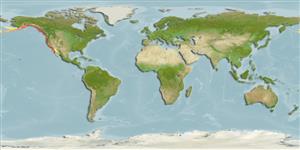Environment: milieu / climate zone / depth range / distribution range
Ecologia
marinhas demersal; intervalo de profundidade 0 - 549 m (Ref. 6793), usually 15 - ? m (Ref. 27436). Temperate; 60°N - 22°N, 177°E - 109°W
Eastern Pacific: Bering Sea coast of Alaska to Cabo San Lucas, southern Baja California, Mexico. Occurrence in Nicaragua (Ref. 13613) needs validation.
Tamanho / Peso / Idade
Maturity: Lm ? range ? - ? cm
Max length : 41.0 cm TL macho/indeterminado; (Ref. 2850); idade máx. registrada: 9 anos (Ref. 72462)
Descrição suscinta
Chaves de identificação | Morfologia | Morfometria
Espinhos dorsais (total) : 0; Raios dorsais (total) : 86 - 102; Espinhos anais: 0; Raios anais : 67 - 81; Vértebras: 38 - 40. Caudal rounded; pectorals rather large and pointed (Ref. 6885). Eyed side dull brown or tan irregularly mottled with dark; Dorsal, anal, caudal and anal fins black; blind side white to pale brown (Ref. 6885). Freshly caught males with dull orange spots and blotches (Ref. 6885). Young light olive green on eyed side, finely and sparsely speckled with brown, black, and orange, especially on fins (Ref. 6885).
Found on sand bottoms (Ref. 2850). Young may occur at depth less than 9 m (Ref. 2850).
Distinct pairing (Ref. 205).
Eschmeyer, W.N., E.S. Herald and H. Hammann, 1983. A field guide to Pacific coast fishes of North America. Boston (MA, USA): Houghton Mifflin Company. xii+336 p. (Ref. 2850)
Status na Lista Vermelha da UICN (Ref. 130435: Version 2024-2)
Ameaça para os humanos
Harmless
Uso pelos humanos
Pescarias: espécies comerciais; peixe esportivo: sim
Ferramentas
Relatórios especiais
Baixar XML
Fontes da internet
Estimates based on models
Preferred temperature (Ref.
123201): 5.5 - 19.4, mean 10.3 °C (based on 1346 cells).
Índice de diversidade filogenética (Ref.
82804): PD
50 = 0.5000 [Uniqueness, from 0.5 = low to 2.0 = high].
Bayesian length-weight: a=0.00977 (0.00418 - 0.02283), b=3.07 (2.86 - 3.28), in cm total length, based on LWR estimates for this (Sub)family-body shape (Ref.
93245).
Nível Trófico (Ref.
69278): 3.5 ±0.3 se; based on diet studies.
Generation time: 3.7 ( na - na) years. Estimated as median ln(3)/K based on 1
growth studies.
Resiliência (Ref.
120179): médio(a), tempo mínimo de duplicação da população 1,4 - 4,4 anos (K=0.30; tmax=11; tm=2.5).
Fishing Vulnerability (Ref.
59153): Low to moderate vulnerability (35 of 100).
Climate Vulnerability (Ref.
125649): Low vulnerability (8 of 100).
Nutrients (Ref.
124155): Calcium = 42.1 [21.2, 71.0] mg/100g; Iron = 0.353 [0.168, 0.598] mg/100g; Protein = 17.3 [15.1, 19.3] %; Omega3 = 0.528 [0.234, 1.062] g/100g; Selenium = 18.3 [10.4, 34.5] μg/100g; VitaminA = 13.4 [3.9, 42.1] μg/100g; Zinc = 0.517 [0.367, 0.717] mg/100g (wet weight);
